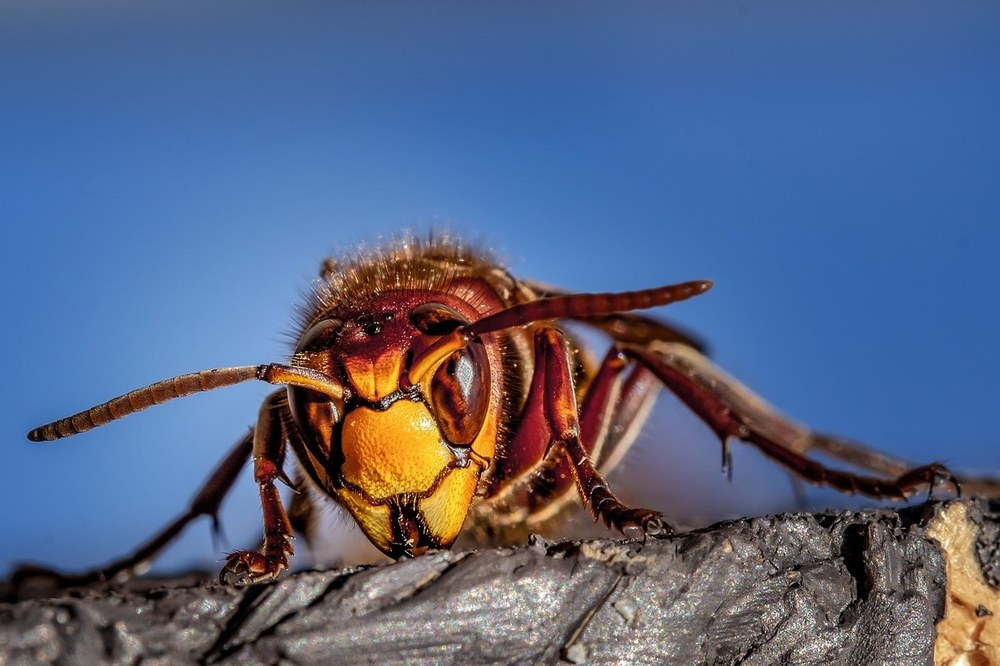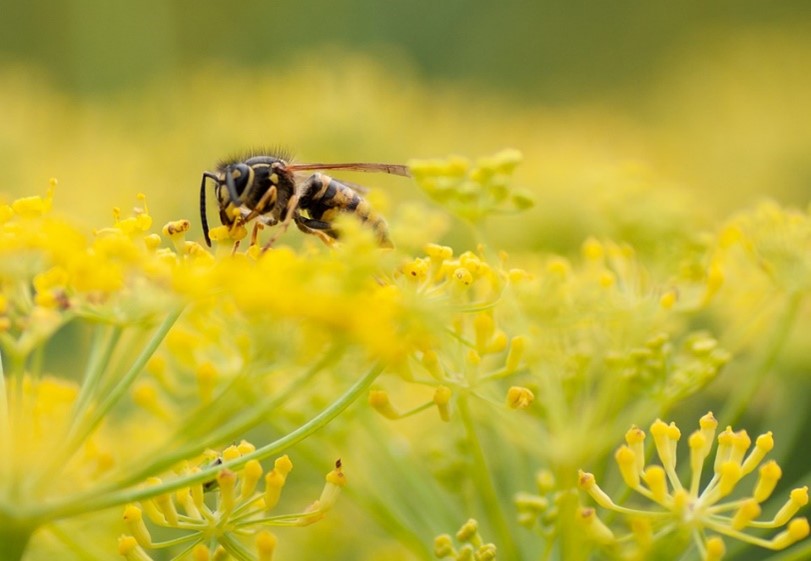Posted: June 15, 2023
Most people think of wasps as a painful pest, but in reality the majority of wasps don't sting. Read about how wasps are essential pollinators and how they are important for the environment.

photo credit: pixabay
Wasps and their role as a beneficial insect and pollinator
At the mere mention of a wasp people's minds will inevitably conjure up those that we are most familiar with, wrapped in bright warning colors the ones that buzz angrily about in groups and threaten us with their painful sting. However, the social wasp species, including the yellowjacket, represents just 1.5% of all wasp varieties. Wasps make up an enormously diverse array of insects, with some 30,000 identified species; 98.5% of the wasp species are solitary non-stinging varieties. "And all do far more good for humans, by controlling pest populations, than harm".
According to University College London biologist Seirian Sumner, it is past time for wasps to get an image makeover. "Despite their poor public image, wasps are incredibly important for the world's economy and ecosystems". "Without them, the planet would be pest-ridden to biblical proportions, with much-reduced biodiversity"3.

People understand that bees sting. However, they are important as pollinators so this is tolerated. Unfortunately, wasps remain disliked largely because of their sting but also due to of lack of understanding about how important their role is in our ecosystem. As habitat becomes more fragmented and pesticide use wide-spread we impact the careful balance within our biodiversity. In a paper, Ecosystem Services Provided by Aculeate Wasps, by Ryan E. Brock, Alessandro Cini, Seirian Sumner, published in 2021 Sumner, along with her colleagues, accumulated data from 500 scientific studies to show the many ways that wasps provide ecosystem services, from pollination and pest control to seed dispersal and in the case of some species that feed on carcasses, decomposition, and nutrient recycling.

On a global basis, they discovered 164 plants that depend solely on wasps as pollinators, including figs which are key to the survival of 1,000 tropical bird and mammal species4.
Wasps are the ancestors of bees, with bees having adopted a vegetarian diet through their entire life cycle as opposed to wasps that are carnivorous during the larval stage when they require a high protein diet. This protein requirement is supplied by adult females who will use their ovipositor to inject venom to paralyze insects and spiders before dragging the prey back to provision their nest for the young. This is true for some species of both social and solitary wasps. Some species of social wasps, like paper wasps, chew the prey and carry it back to the nest for their offspring5. In contrast, a parasitic wasp has an ovipositor modified to sting and lay eggs directly into the host insect. One of the most familiar victims is the Tomato Hornworm (Manduca sexta) which is largely controlled by wasp larvae consuming them. Yet other wasp species are so small that they are used by commercial growers for the control of greenhouse pests including aphids to avoid the use of pesticides. Some wasps are so small that they could fly through the eye of a needle.
Once wasps reach adulthood the need for protein is reduced and the wasps will revert to a largely carbohydrate diet becoming useful as incidental pollinators as they seek nectar for food. Although their bodies are smooth some pollen is still transferred as they forage. Wasps have relatively short tongues and are normally observed on shallow flowers where the nectar is available to them. Wasps represent about 15% of the total flower visiting insects.

To help protect all our pollinators, the volunteers of Penn State Extension Master Gardeners of Monroe County have created a habitat restoration demonstration garden, called Project NatureScape, that provides a welcoming habitat for bees, butterflies, moths, wasps, flies, and beetles. The garden features native plants that support various pollinators.
It also features gardens that the average person can incorporate into their home landscape. The mission statement of Project NatureScape is "Learning from the past, taking action in the present, and protecting the future". The native plants incorporated into Project NatureScape include flowers that are simple and shallow, ideal for wasp's short tongues.
Wasps are attracted to flowers where the insects they hunt are also found. This also gives them the opportunity to feed on the nectar and carry the pollen with them when they depart to the next flower.
Some of the flowers at Project NatureScape that are attractive to wasps as a source of nectar are Erigeron philadelphicus (Fleabane), Eupatorium perfoliatum (Boneset), Eryngium yuccifolium (Rattlesnake Master), Zizia aurea (Golden Alexander), Symphyotrichum novae-angliae (New England Aster) and more. Planting flowers that are attractive to wasps is more likely to create a resilient vegetable or flower garden as well as reduce susceptibility to stings. In terms of ecological pest control wasps are workhorses: without wasps, many of the leaf and seed-eating insects would go unchecked.
While we should invite wasps into our gardens for pest control it is also important to avoid negative interactions with social wasps. Social wasps have a modified ovipositor which they will use to sting repeatedly to defend the nest, and while the nest is aware of movement up to 15 feet away, they really don't become aggressive until movement is detected within 1 to 3 feet of the nest, at which point they will defend the nest fiercely.

Yellowjackets are part of the Vespidae family which have ground nests and will sometimes nest at the base of a building or in pavement cracks. A colony can range in number from a few hundred to a few thousand. There are nine species of ground-nesting yellowjackets in Pennsylvania. In contrast, social paper wasps and hornets build nests from foraged dry grass and dry wood, which they chew to create a papery substance to build the nest. A flat protected surface is the ideal place. This makes under playground equipment or decks, and under the eaves of homes very attractive as nest sites. Colonies are generally small with a few dozen adults but can grow as large as 200 in ideal conditions.
Vespidae begins a ground nest in spring with one reproductive adult female. The first brood will include all females, which is followed in the summer by males. The reproductive females will overwinter alone under leaf litter or dead wood before establishing new nests in the spring. Polistes, paper wasps, follow a similar cycle although they overwinter in groups. In the spring they will establish a hierarchy among themselves before establishing nests either alone or after partnering up with a sibling. Caterpillars are the primary prey of Polistes. For solitary wasp species, the female builds a nest by herself and provisions the nest with prey for her larvae to consume. Most nesting solitary wasps build their nests in the ground, excavating cavities themselves and creating cells inside the nest. Mason wasps look for cavities that are about a half-inch in diameter before producing up to three generations per year. The first generation builds a nest in a cavity, the offspring emerges, and then the offspring build their own nests elsewhere. Other solitary wasps will only have one generation in a year.
The cicada killer wasp, for instance, overwinters as a larva within a cocoon in a burrow in the soil. Pupation occurs in the spring. Adults begin emerging in June and emergence continues throughout the summer. The adult female feeds, mates, and digs burrows for several weeks before preying on cicadas. Although remarkably large in size the Cicada Killer is a solitary wasp and unlikely to sting.

Stem-nesting wasps create nests in the dry stems from the previous growing season. This is one of the reasons why gardeners should leave stems standing over winter rather than cutting them down in fall. Wasps use resin, mud, leaf pieces, or the stem pith to cap off the stem. Wasps that nest in stems use mud for partitions in order to create multiple cells. The deeper the cavity, the more cells they create.
It is important to intervene early if a social wasp nest is in a site likely to cause human interaction. Holes in the ground that invite, Vespid wasps, for example, should be blocked up before spring. Polistes nests, in contrast, should be addressed at night when the wasps are least active, scraping the nest into a container before quickly sealing it; or by shooting a jet of water at the nest from a safe distance. Once a nest becomes established it is far more difficult to deal with, and typically wasps become more defensive later in summer and into fall when local food resources become scarce. This scarcity also causes a decline in the colony's reproductive rate. By winter, the natural life cycle of wasp colonies ends, and this is an ideal time to seal entrances when wasps are no longer active. It is not advisable to seal entrances when the nest is active as the wasps will simply excavate a new entrance which may be even less desirable.
The natural pest control services provided by the vast majority of species of wasps in North America should encourage us to welcome wasps into our gardens.
Wasps will not defend a garden, only their nest, so please consider leaving stems standing over winter, practicing no-till gardening and extending your native plantings to include those that support wasps in order to reap the benefits they bring.
If we can learn to embrace wasps from a distance our habitat will be more resilient for it. Remember: if there is an insect pest, there is a wasp for it.

Article by Catherine Bente, Penn State Master Gardener, Monroe County
Cited Sources:
1 National Geographic: Wasps
3 The Conservation: In Defence of wasps why squashing them comes with a sting in the tale
4 Wiley Online Library: Ecosystem services provided by aculeate wasps
5 Holm, Heather. Wasps: Their Biology, Diversity, and Role and Beneficial
Insects and Pollinators of Native Plants. Minnetonka, MN, Pollination Press, 2021.
Other Resources:
The Xerces Society. Attracting Native Pollinators: Protecting North America's Bees and Butterflies. North Adams, MA, Storey Publishing, 2011.
Penn State Extension: Common Social Bees and Wasps of Pennsylvania: Behavior, Lifecycle, and Management.
The National Wildlife Federation: Reconsidering Wasps
Photo credits, pixabay, online library.wiley.com, LSU Ag Center

